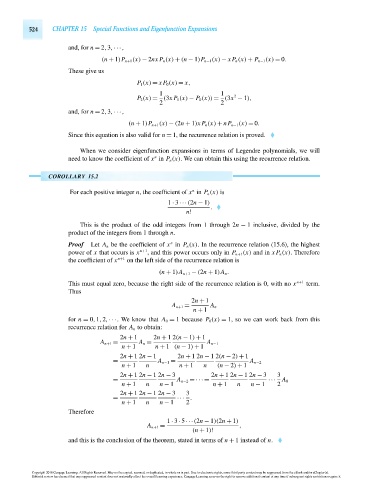Page 544 - Advanced_Engineering_Mathematics o'neil
P. 544
524 CHAPTER 15 Special Functions and Eigenfunction Expansions
and, for n = 2,3,···,
(n + 1)P n+1 (x) − 2nx P n (x) + (n − 1)P n−1 (x) − xP n (x) + P n−1 (x) = 0.
Thesegiveus
P 1 (x) = xP 0 (x) = x,
1 1
2
P 2 (x) = (3xP 1 (x) − P 0 (x)) = (3x − 1),
2 2
and, for n = 2,3,···,
(n + 1)P n+1 (x) − (2n + 1)xP n (x) + nP n−1 (x) = 0.
Since this equation is also valid for n = 1, the recurrence relation is proved.
When we consider eigenfunction expansions in terms of Legendre polynomials, we will
n
need to know the coefficient of x in P n (x). We can obtain this using the recurrence relation.
COROLLARY 15.2
n
For each positive integer n, the coefficient of x in P n (x) is
1 · 3···(2n − 1)
.
n!
This is the product of the odd integers from 1 through 2n − 1 inclusive, divided by the
product of the integers from 1 through n.
Proof Let A n be the coefficient of x in P n (x). In the recurrence relation (15.6), the highest
n
power of x that occurs is x n+1 , and this power occurs only in P n+1 (x) and in xP n (x). Therefore
the coefficient of x n+1 on the left side of the recurrence relation is
(n + 1)A n+1 − (2n + 1)A n .
This must equal zero, because the right side of the recurrence relation is 0, with no x n+1 term.
Thus
2n + 1
A n+1 = A n
n + 1
for n = 0,1,2,···. We know that A 0 = 1 because P 0 (x) = 1, so we can work back from this
recurrence relation for A n to obtain:
2n + 1 2n + 1 2(n − 1) + 1
A n+1 = A n = A n−1
n + 1 n + 1 (n − 1) + 1
2n + 1 2n − 1 2n + 1 2n − 1 2(n − 2) + 1
= A n−1 = A n−2
n + 1 n n + 1 n (n − 2) + 1
2n + 1 2n − 1 2n − 3 2n + 1 2n − 1 2n − 3 3
= A n−2 = ··· = ··· A 0
n + 1 n n − 1 n + 1 n n − 1 2
2n + 1 2n − 1 2n − 3 3
= ··· .
n + 1 n n − 1 2
Therefore
1 · 3 · 5···(2n − 1)(2n + 1)
A n+1 = ,
(n + 1)!
and this is the conclusion of the theorem, stated in terms of n + 1 instead of n.
Copyright 2010 Cengage Learning. All Rights Reserved. May not be copied, scanned, or duplicated, in whole or in part. Due to electronic rights, some third party content may be suppressed from the eBook and/or eChapter(s).
Editorial review has deemed that any suppressed content does not materially affect the overall learning experience. Cengage Learning reserves the right to remove additional content at any time if subsequent rights restrictions require it.
October 14, 2010 15:20 THM/NEIL Page-524 27410_15_ch15_p505-562

